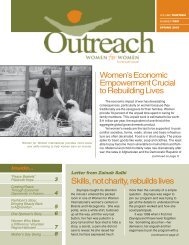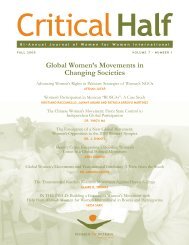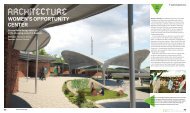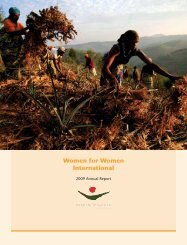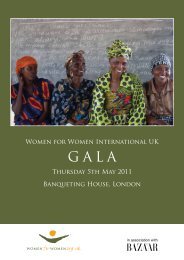Gender and Constitution Building - Women for Women International
Gender and Constitution Building - Women for Women International
Gender and Constitution Building - Women for Women International
Create successful ePaper yourself
Turn your PDF publications into a flip-book with our unique Google optimized e-Paper software.
THE NEW AFGHAN CONSTITUTION:<br />
HOW WOMEN SUCCEEDED IN ENSURING CERTAIN RIGHTS AND WHAT CHALLENGES REMAIN<br />
the opportunity to reassert the fight <strong>for</strong> gender equality.<br />
To succeed, women needed to secure a legal basis <strong>for</strong><br />
ensuring recognition <strong>and</strong> protection of their fundamental<br />
rights. The drafting of a new constitution held this<br />
potential.<br />
<strong>Women</strong>’s Participation in the<br />
<strong>Constitution</strong>al Commission<br />
On December 5, 2001, the Bonn Agreements, which<br />
m<strong>and</strong>ated the Transitional Administration of Afghanistan<br />
to set up a <strong>Constitution</strong>al Commission to draft a<br />
new <strong>Constitution</strong>, were signed. 4 The draft <strong>Constitution</strong><br />
would then be reviewed, discussed <strong>and</strong> adopted at a <strong>Constitution</strong>al<br />
Loya Jirga (Gr<strong>and</strong> Assembly). The Bonn Agreements<br />
envisaged that the new <strong>Constitution</strong> would meet<br />
international st<strong>and</strong>ards <strong>and</strong> provide <strong>for</strong> democracy <strong>and</strong><br />
the rule of law, respect human rights, create independent<br />
institutions aimed at ending the tragic conflict in Afghanistan<br />
<strong>and</strong> promote national reconciliation <strong>and</strong> lasting peace<br />
<strong>and</strong> stability. The Bonn Agreements speak of the right<br />
of the people of Afghanistan to freely determine their<br />
own political future in accordance with the principles of<br />
Islam, democracy, pluralism <strong>and</strong> social justice. This meant<br />
that, as people of that country, Afghan women were now<br />
endowed with the right to political participation.<br />
The <strong>Constitution</strong>al Commission members were recommended<br />
by different groups, such as civil society organizations,<br />
government officials <strong>and</strong> the Afghan Independent<br />
Human Rights Commission. The President of<br />
Afghanistan then appointed the members of the <strong>Constitution</strong>al<br />
Commission from among the recommended persons.<br />
Once assembled, the <strong>Constitution</strong>al Commission<br />
was comprised of 35 members, seven of whom were<br />
women. These women played an important role in ensuring<br />
that women’s fundamental rights were specifically<br />
addressed in the new <strong>Constitution</strong>.<br />
<strong>Constitution</strong>-<strong>Building</strong> <strong>and</strong> <strong>Gender</strong> Issues<br />
A constitution should ensure equal rights <strong>for</strong> all<br />
groups within society, including men, women, children,<br />
minorities <strong>and</strong> the disabled. Also, a constitution will not<br />
work if the people do not underst<strong>and</strong> their rights <strong>and</strong><br />
duties, or find that those rights <strong>and</strong> duties have little or<br />
no relevance in their daily lives. Part of the <strong>Constitution</strong>al<br />
Commission’s m<strong>and</strong>ate required consultation with the<br />
public in order to avoid these pitfalls. The objective was<br />
to draft a <strong>Constitution</strong> that the people agreed with. The<br />
public consultation played an important role in assessing<br />
public opinion regarding which rights <strong>and</strong> government<br />
obligations citizens at the grassroots level wanted to establish<br />
in the <strong>Constitution</strong>.<br />
30 SUMMER 2005<br />
The public consultations revealed that women’s issues<br />
were a high priority. Specifically, <strong>for</strong> many years,<br />
Afghan women had been unable to obtain the same level<br />
of education as men <strong>and</strong> most had been unable to pursue<br />
careers. This was seen as a problem. There was also<br />
evidence of a good deal of violence against women, some<br />
of it a direct result of the turmoil of recent years <strong>and</strong><br />
some of it a result of the stresses that circumstances<br />
had placed on society as a whole. Customs in particular<br />
communities that weighed heavily on women, such as<br />
<strong>for</strong>ced marriages <strong>and</strong> the practice of giving away daughters<br />
as a way of settling disputes, were also cause <strong>for</strong><br />
concern. The customary practices were often en<strong>for</strong>ced<br />
by in<strong>for</strong>mal justice systems operating in rural areas. These<br />
in<strong>for</strong>mal decision-making bodies act in both criminal <strong>and</strong><br />
civil disputes <strong>and</strong> matters within a community. Their<br />
decisions are very much respected by the community<br />
members, even though they often violate women’s basic<br />
<strong>and</strong> fundamental rights.<br />
Coordination by <strong>Women</strong>’s Rights Advocates<br />
Faced with this situation, Afghan women activists,<br />
NGO workers <strong>and</strong> other members of civil society started<br />
coordinating their ef<strong>for</strong>ts country wide to ensure that<br />
women’s fundamental rights were recognized in the new<br />
Afghan <strong>Constitution</strong>. Because the members of the <strong>Constitution</strong>al<br />
Commission were picked by the president<br />
based on recommendations from civil society <strong>and</strong> other<br />
groups, it was important that women’s groups be engaged<br />
at the recommendation, rather than the selection<br />
stage of the process. However, the advocates also needed<br />
to be careful about how they presented women’s rights<br />
claims. Again <strong>and</strong> again throughout the country’s history,<br />
the Afghan people have shown that they are against<br />
any kind of imported culture. It was clear that if women’s<br />
rights were to be widely accepted <strong>and</strong> realized, they must<br />
not be perceived as imposed by <strong>for</strong>eign interests.<br />
A <strong>Gender</strong>-Based Approach<br />
In making recommendations <strong>for</strong> the <strong>Constitution</strong>,<br />
Afghan women’s rights advocates had to grapple with<br />
the very real conflicts <strong>and</strong> tensions between popularly<br />
held interpretations of religion <strong>and</strong> tradition on the one<br />
h<strong>and</strong>, <strong>and</strong> st<strong>and</strong>ards <strong>for</strong> the promotion <strong>and</strong> protection<br />
of women’s human rights on the other. Once women<br />
were at the negotiating table <strong>and</strong> engaged in the drafting<br />
process, as was required by the Bonn Agreements, it<br />
became clear that in some cases the words used to describe<br />
the rights to be protected were just as important<br />
as the rights themselves. For instance, it was very important<br />
to Afghan women to include the term “men <strong>and</strong>



